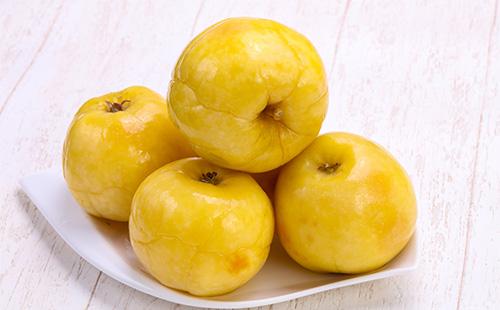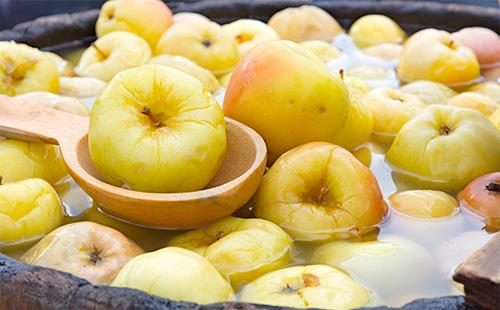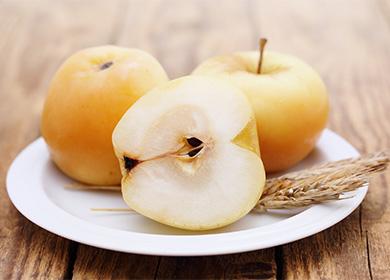Apples are so common in domestic latitudes that they seem quite mundane. With pleasure eating juicy fruits, few people think about history, legends and statistics. You will love apples even more if you get to know some interesting facts about them.
- Countless varieties. At the moment, there are more than 7 thousand varieties of apples. It is impossible to name the exact number, since almost every day new varieties appear with the light hand of breeders. They have not only gastronomic, but also decorative and technical purposes.
- A symbol of life and longevity. This is how apple is characterized in many world cultures. For example, the ancient Slavs gave the fruit to a newborn so that it grows strong and healthy. And in some regions of Germany there is a beautiful tradition of planting an apple tree in honor of the birth of a child.
- The first Christmas tree toy. In the XVI-XIX centuries, Europeans decorated Christmas trees with apples. The tradition was violated due to a strong crop failure. Then glass blowers came up with colorful balls, the prototypes for which were apples.
- Record-breaking fruits. The smallest apple listed in the Guinness Book of Records, barely exceeds the size of a pea. But the largest fruit was the size of a human head and weighed almost 2 kg.
- The executor of desires. The ancient Persians believed that if you eat 40 apples in a row, after blowing on each, the most cherished dream will come true. But this matter must be approached responsibly. If you just bite the fruit or stop halfway, troubles can fall on the eater.
More useful than wood
The beauty of soaked apples is that the concentration of nutrients in them is an order of magnitude greater than in fresh ones. That is the value of the workpiece.
- Vitamin B1 (thiamine). Regulates carbohydrate and lipid metabolism in the body. It is thanks to him that energy is generated in the cells for the normal functioning of organs. It takes part in cell division.
- Vitamin B2 (riboflavin). It is called a “beauty vitamin”, because the state of hair, skin and nails depends on its concentration in the body. And the substance regulates metabolism and stimulates reproductive function.
- Vitamin B3 (nicotinic acid). Indispensable for the treatment of cardiovascular diseases and skin problems. Enhances brain activity and suppresses nervous tension.
- Vitamin B6 (pyridoxine). Provides protein metabolism and transport of iron to the bone marrow. He also stabilizes the central nervous system by regulating its excitability.
- Vitamin B9 (folic acid). The substance maintains a healthy state of new cells, therefore it is necessary for a growing body, as well as for pregnant women. Regulates the immune system and blood forming organs.
- Vitamin B12 (cobalamin). Stimulates the synthesis of red blood cells and prevents their destruction. Prevents fatty degeneration of the liver of the heart and kidneys.
Workpiece Features
Urination, along with pickling and salting, is one of the oldest methods of harvesting fruits. So harvested apples, pears, watermelons, fragrant berries (lingonberries, cherries), cucumbers and much more. This method is not very popular right now, but once you try a soaked apple, you will want to learn how to make such a treat yourself.
Essence of the process
The essence of the urination process is that under the influence of lactic acid bacteria and natural yeast (they are also called “wild”), the sugar that is part of apples is transformed into alcohol, lactic acid and carbon dioxide. These substances provide a preservative effect, preventing decomposition and decay of the fruit. They acquire a pleasant sour taste and rich aroma.
To our time, the urination procedure has come almost unchanged. Only the packaging has changed. From ancient times apples were soaked in large oak barrels. But now such a luxury is not widely available. Yes, and modern man does not need such colossal volumes of procurement. Therefore, traditional barrels are successfully replaced by enameled pots, plastic buckets and glass bottles.
Wet apples for the winter is a science. Of course, each mistress has her own secrets and tricks, but there are five points that are mandatory.
- Temperature mode. The first ten days, the workpiece should be at a temperature not exceeding 20 ° C.
- The beginning of fermentation. The appearance on the surface of the foam is a signal of the beginning of the fermentation process (it is better to remove it).
- Degassing. To allow excess gas to escape, the workpiece must be pierced with a spoke in several places (it is important that the hole reaches the bottom of the tank).
- Change in temperature. From the moment fermentation begins, the temperature regime needs to be changed to cold (cellar, refrigerator or balcony).
- Availability and storage. After one and a half to two months, the soaked apples will be ready, and they can be kept for a whole year at a storage temperature of 0-10 ° C.

Raw material selection
Autumn and winter varieties of apples, characterized by a sweet and sour taste and dense pulp, are more suitable for urinating. This is Antonovka, Saffron Pepin, Anis, Ranet, Calvili. But you can use summer varieties with similar characteristics. For example, "White filling". But there is one condition. Summer varieties of apples need to be processed immediately after harvest. But in autumn and winter you need to let lie down a couple of weeks, so that the concentration of sugars in the fruits reaches a maximum.
It is not only the variety that matters, but also the physical characteristics of the fruits. They should be tight and strong without any signs of damage. There should be no dark spots or scab on apples. This spoils not only the appearance of the workpiece, but also its taste. Fruits with scratches, punctures and cracks are also rejected, as in the process of urination they will be oversaturated with a solution and will become tasteless and useless.
Soaked apples: recipes
If you want to open a new page in the field of homemade products, you just need to cook soaked apples. They will get not just a refreshing sourness, but even an alcoholic note. And the brine will turn out a little carbonated, like kvass.
Rustic
Features Soaked apples "Antonovka", "White filling", "Ranet", "Pepin" and other varieties are especially tasty if cooked in a barrel.A container made of natural material not only ensures the long-term preservation of the product, but also saturates them with the tart aroma of wood. If you have where to store a large barrel with a workpiece, give preference to the original old recipe.
You will need:
- apples
- straw;
- blackcurrant leaves;
- tarragon;
- mint;
- 150 g of malt for every 10 liters of water;
- 400 g of sugar for every 10 liters of water;
- 90 g of salt for every 10 liters of water (you can do without salt - this is at your discretion).
Cooking
- Rinse the straw well, scald with boiling water and lay on the bottom of the barrel with a layer of 3 cm.
- Lay the apples in one layer, and on top - currant leaves and tarragon.
- Continue peeling apples with leaves until you fill the container to the top.
- Boil the malt in an appropriate amount of water and let stand for about an hour.
- Strain the broth, dilute bulk products in it and pour into the barrel.
- Put the workpiece under oppression.
- Keep at room temperature until fermentation begins, then refrigerate.
Easy peasy
Features A simple recipe for soaked apples for the winter is suitable even for those who are first faced with a similar technology for harvesting fruits. A minimal set of ingredients and a simple cooking method give an excellent result. The amount of ingredients is indicated per 1 kg of fruit. Correct it depending on the volume of the container.
You will need:
- 1 kg of apples;
- 1.5 liters of water;
- 120 g of sugar;
- 50 g of salt;
- cherry and currant leaves;
- cloves, cinnamon and mustard seeds of your choice.
Cooking
- Cover the bottom of the container with washed leaves.
- Lay two layers of apples on top and cover them with a layer of leaves.
- Continue alternating until the tank is full. Leaves complete the “composition”.
- Boil water with spices and dissolve loose ingredients in it.
- When the pour has cooled to about 35 ° C, fill it with apples and put under oppression.
- About a week, keep the workpiece at room temperature, and when the fermentation process begins, move it to cold.
- In one and a half to two months, the apples will be ready.

Sour with cabbage
Features If you want to reveal a new facet of sweet fruits, try making soaked apples for the winter with cabbage. The fruits will be saturated with a sourish-salty taste. The delicacy will not be dessert, but rather a snack.
You will need:
- 3 kg of apples;
- 4 kg of cabbage;
- two carrots;
- 60 g of sugar;
- 90 g of salt.
Cooking
- Chop the cabbage finely, and grate the carrots.
- Mix vegetables with bulk products and leave until juice appears.
- Put the carrot-cabbage layer on the bottom of the container and tamp well.
- Put a layer of apples on top.
- Transfer vegetables with apples until the container is full.
- Pour the juice that the vegetables isolated into the container.
- Put oppression on top.
- Before fermentation, keep the workpiece at room temperature, and then transfer to cold.
- You can taste it in a month.
With mustard
Features Amazing, unlike anything fragrance gives apples floral honey and mustard. The last component is not just a flavoring supplement, but also an excellent preservative. Fruits soaked in mustard fill are perfectly stored at home.
You will need:
- 10 kg of apples;
- blackcurrant leaves;
- horseradish leaves;
- three tablespoons of mustard powder;
- 400 g of honey;
- 100 g of salt;
- 5 liters of water.
Cooking
- Lay blackcurrant leaves and apples in layers in a clean container.
- Dissolve salt with honey in boiling water and wait until it cools completely.
- Fill the container with apples and fill it under oppression.
- When fermentation begins, clean in a cold place for a month and a half.
With mountain ash
Features In a city apartment, it is most convenient to cook soaked apples in jars for the winter. For this purpose, choose small fruits that easily pass through the neck of a three-liter jar. Harvesting is done without leaves, and ripe mountain ash is used as a preserving agent. This option can be called a quick recipe, because you can enjoy the soaked fruits in less than a month.
You will need:
- tarragon
Cooking
- Place the rowan apples and berries from the bunch in a container.
- Boil water, dissolve loose additives in it and wait for cooling.
- Fill the fruit bowl with filling.
- Put under oppression, and when fermentation begins, put it in the cold.
Another reason to learn how to soak apples for the winter is skin problems. According to historical rumors, Princess Anna Yaroslavna, the future queen of France, in her 20s suffered from acne. The court healers advised her to eat soaked apples. It was thanks to this miraculous delicacy that she got rid of the rashes and appeared at her wedding with King Henry I in all its glory.
Other homemade recipes
Candied pumpkin
Roasted peppers for the winter
Raspberry jam
Gooseberry Jelly

